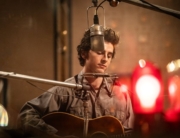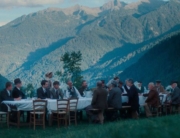Written & Directed by Nicolas Winding Refn
Produced by Marc Platt, John Palermo, Gigi Pritzker, Michael Litvak & Adam Siegel
Released by FilmDistrict
USA. 100 min. Rated R
With Ryan Gosling, Carey Mulligan, Bryan Cranston, Oscar Isaac, Christina Hendricks, Ron Perlman & Albert Brooks
![]() It shouldn’t have surprised me that the new thriller Drive, for which director Nicolas Winding Refn won the best director prize at Cannes this year, takes its inspiration just as much from samurai films (at least according to Refn in interviews) as well as classic and cool noir thrillers. It also feels like it’s ripped right out of the pulp action films of the 1970s or ’80’s, with Ryan Gosling playing a surrogate of Steve McQueen’s quiet tough guy roles, only here twinged with a much darker side that comes out only when provoked.
It shouldn’t have surprised me that the new thriller Drive, for which director Nicolas Winding Refn won the best director prize at Cannes this year, takes its inspiration just as much from samurai films (at least according to Refn in interviews) as well as classic and cool noir thrillers. It also feels like it’s ripped right out of the pulp action films of the 1970s or ’80’s, with Ryan Gosling playing a surrogate of Steve McQueen’s quiet tough guy roles, only here twinged with a much darker side that comes out only when provoked.
How mysterious is Gosling’s protagonist? His name is never mentioned—on IMDb.com he’s credited as “Driver.” His daytime profession is a stunt driver in the movies. By night, he drives criminals to and from their jobs. (“I give you a five minute window, and I’m yours no matter what,” he deadpans in the first shot of the film to the respective criminal on the phone.) When he meets an emotionally fragile next door neighbor and single mother, Irene (Carey Mulligan), it makes for a nice diversion from the movies and working with his longtime partner-in-crime, mechanic Shannon (the always awesome Bryan Cranston).
Things get messy, however, with the reappearance of Irene’s ex-convict husband, Standard, played by Oscar Isaac. Reluctantly, Driver takes on a job to help Standard pay off his loan to mobsters by robbing a pawn shop… which doesn’t go well at all. And as his bad luck turns out, Driver becomes mixed up with the very thugs—former producer Bernie Rose (Albert Brooks) and a-hole Nino (Ron Perlman)—for whom he and Shannon were making a custom-made car. From here, it’s a pressure cooker kind of story.
Refn’s film is at times surprisingly delicate, particularly in the early scenes where Driver becomes close with Irene and her son. (Refn uses at first some annoying but then catchy ’80’s synth-pop music, separate from Cliff Martinez’s wonderful pulse-pounding score). And then it becomes extreme with its violence, but in such a way that fits the subject matter. The violence is shocking and brutal, sometimes for what we see and sometimes not. When Driver and Irene are in an elevator and a shady gentleman enters, we see how unforgiving Driver can be for anyone coming close to him and the woman he cares for. The scene starts out kind of unreal, with the lighting becoming very white and bright, and as Driver moves Irene out of the way, the action goes into slow motion for just a beat. And then the carnage ensues.
There’s a real vision behind what’s going on. It calls attention to itself only when needed (the story takes on an operatic touch when the shit hits the fan). And like in a good samurai movie, the main character retains a sense of mystery, disconnected from those around him until he gets close. When violence bursts out, it’s quick and bloody.
Gosling is especially affecting. Though cool a la McQueen, there’s something else to his actions that makes his performance alive and sophisticated. Often his acting (Blue Valentine first comes to mind) is alive by always being engaged with the actors he’s playing against, but here he has to pull back a little, while letting Driver deal with his primal side. But it’s Perlman, Cranston, and especially a nasty villain in Brooks that steal their scenes. It’s startling to see the same actor from Broadcast News and Real Life transform into a threatening presence, but Brooks pulls it off, albeit with a touch of needed sleaze, yet he never slips into self-parody.
Drive is ultimately a must-see cult film in mainstream clothing, an experience that is visceral, cool, and occasionally very funny. A director from the fringe (Refn’s previous films include Bronson and Valhalla Rising) breaks into Hollywood and cracks some skulls.






It is strange that I never see this film compared to 1978’s THE DRIVER. http://www.imdb.com/title/tt0077474/ Much of the plot and feel comes right out of the earlier film.